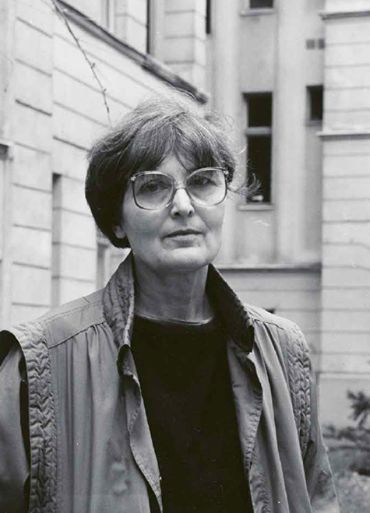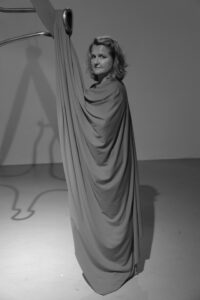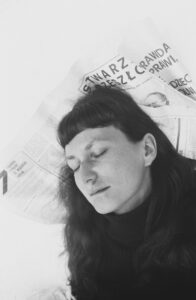Margit Szilvitzky

– born 1931, died 2018, Budapest. She graduated from the textile and fashion design department of the University of Applied Arts Budapest in 1954. She became an acclaimed designer by the end of the fifties. In parallel she began experimenting with various textile fabrics, and her sewn collage pictures, made from linen and hemp materials she had dyed herself, made her by latter half of the sixties one of the leading figures of the Hungarian textile art.
For me, the material is not a tool to carry out my plans, but the opportunity itself that I need to mould. I consider it important that the shapes, forms and surfaces arising from the fibrous, rather coarsely woven materials behaving according to their own rules, be sensitively matched to the essence of what is being said. – Margit Szilvitzky
Margit Szilvitzky graduated from the Hungarian University of Applied Arts in 1954. She worked as a designer until the mid-1960s, specializing in dressing, object and set design. Within the framework of the Complex Textile Studio of the Fine Arts Fund, she presented her collections at modern, progressive fashion shows. From the early 1970s, her activity in applied arts was accompanied by an increasingly intense practice dedicated to fine arts. Szilvitzky took an active role in the renewal of textile art that gained momentum in the late sixties, and in the development of the visual language of experimental textile that broke down boundaries between genres. Her textile-based collages, objects and installations situate her as a leading figure of Hungarian neo-avant-garde textile art.
She debuted as a textile artist in 1968 with her iconic embroidered, sewn textile collage entitled Spring at the Textile Mural exhibition of the Ernst Museum in Budapest12. It is in the mid-1970s that she turned to the white canvas as a medium for the visual representation of thought processes. With the geometric variations of the canvas folds, she sought to synthesize and process space, material and form. Szilvitzky aimed to explore three-dimensional space with the technical possibilities inherent in the use of textiles of natural origin, thus joining the ranks of an increasingly distinct international tendency of post-war abstraction, which gave textiles a central role. Although the artist moved from early colour-rich, figural embroidery collages to strictly geometric spatial folds made of raw canvas, she used simple, natural materials throughout her artistic career34.
Margit Szilvitzky’s practice unfolded in parallel with the development of Hungarian neo-avant-garde textile art, nourished from its impetus, while also leading the way for the movement that flourished in the seventies. In addition to Szilvitzky, the first generation of Hungarian textile artists who started out in the sixties also included Gábor Attalai, Klára Kuchta, Zsuzsa Szenes and Aranka Hübner, among others. These artists, who worked primarily with textile and regarded it as an autonomous medium, in parallel to a distancing from the applied arts, also thematised the then-current topics problematized in international fine arts-related discourse. In addition to the novelty factor, the reason textile art could gain enough momentum to grow into a movement during the seventies on the periphery of political attention was that – outside the traditional categories of high art – the Wall and Space Textiles Biennial, from the get-go, ensured an institutional framework for the new, experimental genre of three-dimensional textile art. In addition to exhibiting regularly at the Wall and Space Textile Biennials, she also participated in several international group exhibitions56.
In parallel with the new, expressive aspirations that gave a strong impetus to painting in the 1980s, Szilvitzky’s interest turned to space as a visual problem that could be displayed on a plane. The paintings she realized on large-scale, colourful laufer canvases, as well as her smaller-format tempera paintings and drawings were definite steps in the direction of painting. The sewn laufer canvases stretched on a blind frame and made in the eighties marked a transition between earlier space textiles and acrylic paintings realized in the nineties78. In her acrylic paintings, she aimed to display the material properties and layers of the paint as vividly as possible. In addition to acrylic paintings, she also examined the spatial dimension and its variability in her works emphasizing the geometric structure of unfolded boxboards. In addition to her applied and fine art practice, Margit Szilvitzky also had a significant pedagogic activity as a professor at the University of Applied Arts and later at the Moholy-Nagy University of Art and Design. In her teaching program, she gave a prominent role to the development of creative visual thinking – developed according to the practice of the Bauhaus school –, in which she introduced the students to a broad interpretation of textile art as an integral part of visual arts910.
− Fanni Magyar (2020).
1Image: Margit Szilvitzky, Spring, 1968, sewn textile collage, 96 x 180 cm, photo Miklós Sulyok. Courtesy the estate of the artist.2Image: Margit Szilvitzky, Flags 1-6., 1970, sewn textile collage, 120 x 330 cm. Courtesy the estate of the artist and acb Gallery, Budapest.
3Image: Margit Szilvitzky, 100x100 Square 1-3., 1976, sewn, folded textile, 51 x 150 cm. Courtesy the estate of the artist and acb Gallery, Budapest.
4Image: Margit Szilvitzky, Floor object 1, 1977, sewn textile, 18 x 32 x 45 cm. Courtesy the estate of the artist and acb Gallery, Budapest.
5Image: Margit Szilvitzky, Modulation, 1977, sewn, ironed textile, variable dimensions. Courtesy the estate of the artist and acb Gallery, Budapest.
6Image: Margit Szilvitzky, Aeruginous, 1979, painted canvas and silk collage, 120 x 124 cm. Courtesy the estate of the artist and acb Gallery, Budapest.
7Image: Margit Szilvitzky, My friend Olga Rozanova, 1987, acrylic, laufer, silk on canvas, 230 x 283 cm, photo: Miklós Sulyok. Courtesy the estate of the artist.
8Image: Margit Szilvitzky, Aero series No. II, 1989, crayon, collage on paper, 31 x 41 cm. Courtesy the estate of the artist.
9Image: Margit Szilvitzky, Unfolded image, 1995, acrylic on boxboard, 30 x 40 cm. Courtesy the estate of the artist.
10Image: Margit Szilvitzky, Unfolded image with oval forms, 2009, acrylic on boxboard, 39 x 50 cm. Courtesy the estate of the artist.
– szül. 1931, elhunyt 2018 – az ötvenes években textil tervezőként kezdte pályafutását, majd a hatvanas évek második felétől a tértextil, a nyolcvanas és kilencvenes évek során pedig a festészet képzőművészeti műfajai felé fordult. Szilvitzky tevékeny szerepet vállalt a textilművészet megújításában, a műfaji határokat lebontó experimentális textil nyelvezet formálásában. A textil alapú kollázsai, objektjei és installációi a magyar neoavantgárd textilművészet irányadó alakjává tették.
Számomra nem eszköz az anyag terveim kivitelezéséhez, hanem maga a lehetőség, amelyet formába kell öntenem. Fontosnak tartom, hogy a szálas, meglehetősen durván szőtt anyagok öntörvényeiből fakadó formák, alakzatok, felületek érzékenyen illeszkedjenek a mondanivaló lényegéhez. – Szilvitzky Margit
Szilvitzky Margit 1954-ben diplomázott a Magyar Iparművészeti Főiskolán. Az 1960-as évek közepéig tervezőként dolgozott, területe az öltözködés, tárgy- és látványtervezés volt. A Képzőművészeti Alap Komplex Textil Stúdiója keretében modern szemléletű, iránymutató divatbemutatókon mutatta be kollekcióit. Iparművészeti munkásságát a hetvenes évek elejétől egyre intenzívebbé váló képzőművészeti tevékenység kísérte. Szilvitzky tevékeny szerepet vállalt a hatvanas évek végén lendületet kapott textilművészet megújításában, a műfaji határokat lebontó experimentális textil nyelvezet formálásában. A textil alapú kollázsai, objektjei és installációi a magyar neoavantgárd textilművészet irányadó alakjává tették.
Textilművészként 1968-ban mutatkozott be Tavasz című emblematikus hímzett, varrott textil kollázsával a budapesti Ernst Múzeum Textil falikép kiállításán12. Majd a hetvenes évek közepén talált rá a fehér vászon használatára, mint a gondolati folyamatok vizuális megjelenítésének hordozójára. A vászonhajtogatások geometrikus variációival a tér, az anyag és a forma szintézisére, folyamatszerű megragadására törekedett. A természetes eredetű textilek használatában rejlő technikai lehetőségeken keresztül Szilvitzky a tér vizsgálatát tűzte célul, amellyel a háború utáni absztrakció egy mind karakteresebbé váló, a textilnek központi szerepet biztosító nemzetközi tendenciájához csatlakozott. A művész ugyan a korai színgazdag, figurális hímzéses kollázsoktól, a szigorúan geometrikus térbeli nyers vászon hajtogatásokhoz jutott el, az egyszerű, természetes anyagok használata azonban végigkísérte művészetét34.
Szilvitzky alkotói pályája a hazai neoavantgárd textilművészettel párhuzamosan bontakozott ki, annak lendületéből merített, munkásságával azonban egyúttal irányt is adott a hetvenes években virágzó mozgalomnak. A magyar textilművészet első, a hatvanas években induló generációjának Szilvitzky Margit mellett többek között Attalai Gábor, Kuchta Klára, Szenes Zsuzsa és Hübner Aranka is tagjai voltak. Ezek, a textilre elsődleges, autonóm médiumként tekintő alkotók az iparművészettől való függetlenedéssel párhuzamosan a nemzetközi képzőművészeti diskurzus aktuális kérdéseit tematizálták. Újszerűsége mellett azért is erősödhetett mozgalommá a hazai textilművészet a hetvenes évek során, mert a magas művészet hagyományos kategóriáin kívül, a politikai figyelem perifériáján, a szombathelyi Fal- és Tértextil Biennále szinte a kezdetektől intézményes keretet biztosított a tértextil új, kísérleti műfajának. Amellett, hogy a Fal- és Tértextil Biennálék rendszeres kiállítója volt, számos nemzetközi csoportos kiállításon is szerepelt56.
A nyolcvanas években a festészetnek erőteljes lendületet adó új, expresszív törekvésekkel párhuzamban Szilvitzky érdeklődése a tér, mint síkon megjeleníthető vizuális probléma felé fordult. Nagy méretű, színes laufer vásznakból készített ráfestéssel képeket, valamint kisebb formátumú tempera festményeket és rajzokat, amelyek már a festészet irányába tett fordulat határozott lépései voltak. A nyolcvanas években készült vakrámára feszített, varrott laufer vásznak a korábbi tértextilek, valamint a kilenceves években készült akril festmények közötti átmenetet jelentették78. Akril festményeiben a festék anyagának, rétegeinek minél elevenebb megjelenítését tűzte célul. Az akril festmények mellett, a széthajtogatott dobozkartonok geometrikus struktúráját kihangsúlyozó műveiben is a síkba terelt téri dimenziót, annak variabilitását vizsgálta. Szilvitzky Margit tervezői és képzőművészeti tevékenysége mellett jelentős oktatói tevékenységet is folytatott az Iparművészeti Főiskola majd a Moholy-Nagy Művészeti Egyetem professzoraként. Oktatói programjában kielemelt szerepet kapott – a Bauhaus iskola gyakorlata nyomán kidolgozott – a kreatív vizuális gondolkodás fejlesztése, amelyben a tágan értelmezett textilművészetet a vizuális művészetek integráns részeként ismertette meg a hallgatókkal910.
− Magyar Fanni (2020).
1Kép: Margit Szilvitzky, Tavasz, 1968, varrott textil kollázs, 96 x 180 cm, fotó Sulyok Miklós. A művész hagyatéka.2Kép: Margit Szilvitzky, Zászlók 1-6., 1970, varrott textil kollázs, 120 x 330 cm. A művész hagyatéka és az acb galéria jóvoltából.
3Kép: Margit Szilvitzky, 100x100 Négyzet 1-3., 1976, varrott, hajtogatott textil, 51 x 150 cm. A művész hagyatéka és az acb galéria jóvoltából.
4Kép: Margit Szilvitzky, Padló objekt 1., 1977, varrott textil, 18 x 32 x 45 cm. A művész hagyatéka és az acb galéria jóvoltából.
5Kép: Margit Szilvitzky, Moduláció, 1977, varrott, vasalt textil, változó méret. A művész hagyatéka és az acb galéria jóvoltából.
6Kép: Margit Szilvitzky, Méregzöld, 1979, festett vászon és selyem kollázs, 120 x 124 cm. A művész hagyatéka és az acb galéria jóvoltából.
7Kép: Margit Szilvitzky, Barátnőm Olga Rozanova, 1987, laufer, selyem, vászon, akril, 230 x 283 cm, fotó: Sulyok Miklós. A művész hagyatéka és az acb galéria jóvoltából.
8Kép: Margit Szilvitzky, Aero serie No. II., 1989, zsírkréta, papír, kollázs, 31 x 41 cm. A művész hagyatéka és az acb galéria jóvoltából.
9Kép: Margit Szilvitzky, Kihajtogatott kép, 1995, akril, dobozkarton, 30 x 40 cm. A művész hagyatéka és az acb galéria jóvoltából.
10Kép: Margit Szilvitzky, Kihajtogatott kép ovális formákkal, 2009, akril, dobozkarton, 39 x 50 cm. A művész hagyatéka és az acb galéria jóvoltából.



